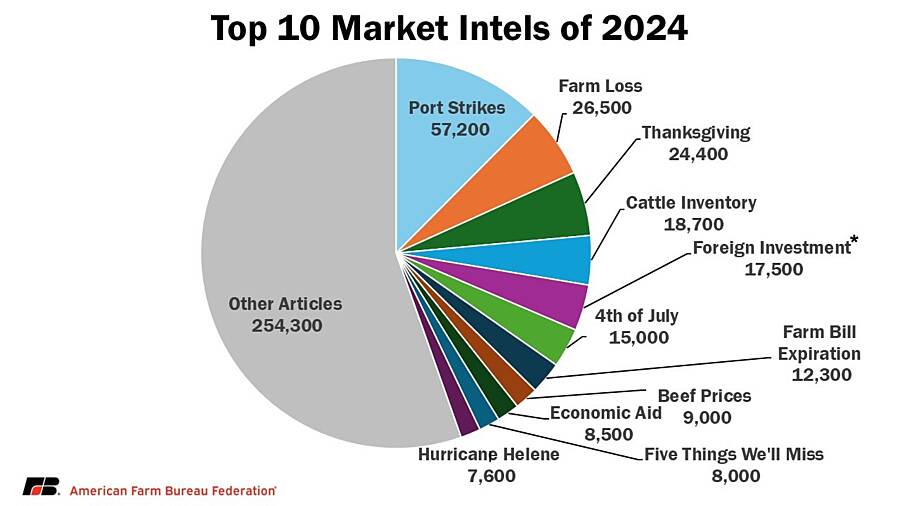Market Intel Wrapped 2024

photo credit: Dylan Davidson, AFBF
Samantha Ayoub
Associate Economist
In 2024, your American Farm Bureau Federation economics team published 63 Market Intel reports covering a wide range of topics. These and other Market Intels from the last seven years of publication were read 459,000 times this year. Here were our faithful readers’ top 10 Market Intel reads published in 2024:
10. Hurricane Helene Devastates Rural Southeast
As the most powerful hurricane ever to strike Florida’s Big Bend region and the deadliest Atlantic storm since Hurricane Maria in 2017, Helene left affected communities not only grieving for lost loved ones but also grappling with the overwhelming challenge of rebuilding their homes, farms, and livelihoods. While it was too early to estimate total agricultural losses, understanding the region's agricultural profile offered a glimpse of what recovery might look like. This article examined long-term challenges rural communities face as they rebuild.
9. Five Things We’ll Miss Without a New Farm Bill
The 2018 farm bill went into 2024 on a one-year extension. Six years of tumult – including the highest inflation in 40 years and geopolitical disruptions to markets for the things farmers buy and sell – left key parts of the 2018 farm bill outdated. As we move into another year of farm bill negotiations in 2025, this Market Intel outlines the short-comings of the now seven-year old farm bill.
8. Three Reasons Why Farmers Need Economic Aid
The week of Dec. 16 brought intense Congressional debate over what to include in the year-end continuing budget resolution. With emergency economic aid for farmers and ranchers on the chopping block, this Market Intel outlined farmers’ need for help.
7. Beef Prices Soar to Record Highs, Yet Farmers Struggle to Reap the Benefits
July 2024 marked the first time in history that the national average price for all fresh beef moved above $8, according to USDA’s Economic Research Service. While the cash price for cattle was (and still is) elevated, increased costs for supplies and market uncertainty, have obscured the profit outlook for cattle farmers and ranchers, stunting growth of the U.S. cattle herd.
6. What Happens When a Farm Bill Dies
The 2018 farm bill expired on Sept. 30, 2024. Other Market Intel articles explored why the 2018 farm bill is outdated, but this article focused on what occurs when one officially expires. Although it was extended for a year in the end-of-year continuing resolution, many programs were suspended for months upon the September deadline, and farmers and ranchers waited in limbo to see what the last three months of the year would hold for the farm bill.
5. Record High July 4th Cookout Costs: Inflation Hits the Backyard
Similar to our long-standing Thanksgiving meal survey, volunteers from across the United States contribute to American Farm Bureau’s Fourth of July market basket survey to determine the average cost of summer cookout staples. This year was the most expensive Fourth of July grocery bill in the history of the survey. This Market Intel considered the market pressures driving your grocery bill, as well as how inflation and an outdated farm bill were affecting farmers and ranchers.
4. U.S. Cattle Inventory Smallest in 73 Years
This Market Intel provided analysis of the Jan. 1 Cattle Inventory Report, which became the only cattle inventory data released in 2024. The overall cattle inventory was historically low, yet the supply of cattle on feed was quite large. This provided opportunities for profitability in the cattle business in 2024, but a smaller calf crop and fewer replacement heifers also led to record beef prices for consumers.
3. Thanksgiving Dinner Costs are Down Again
The 39th annual American Farm Bureau Federation Thanksgiving dinner survey was released on Nov. 20, 2024. This detailed analysis of what drove costs for Thanksgiving classics looked at agricultural production, rising input costs for farmers and inflation pressures.
2.Over 140,000 Farms Lost in 5 Years
USDA released the 2022 Census of Agriculture on Feb. 13, 2024. This Market Intel examined declines in farms and agricultural land between the 2017 and 2022 censuses.
1. Port Strike Could Sink Access to Foreign Markets
Negotiations between the International Longshoremen’s Association (ILA) and the United States Maritime Alliance (USMX) looked to be at a stalemate as we approached the expiration of their contract on Sept. 30, 2024. The ILA is the largest union of maritime workers in North America, representing nearly 85,000 longshoremen across the Atlantic and Gulf coasts, Great Lakes, major U.S. rivers, Puerto Rico, Eastern Canada and the Bahamas. On the employer side, USMX represents approximately 40 ocean carriers and terminal operators where ILA members work. As we approached a looming port strike, this Market Intel explored the possible effects on both farmers and consumers. While a temporary agreement was reached in September, the threat of a strike continues with contract negotiations continuing through January 15, 2025.
*Honorable Mention: Foreign Investment in U.S. Ag Land – The Latest Numbers
Although this article was published in 2023, foreign investment in U.S. agricultural land remained a hot topic, largely spurred by media reports raising concerns about bad actors from adversarial nations purchasing land for potentially hostile purposes. Lawmakers in both chambers of Congress and the Committee on Foreign Investment in the United States (CFIUS) in 2024 continued to investigate and work towards increased oversight of foreign investment of productive farmland.
On to 2025
As we say goodbye to 2024, we expect another year where many of these articles will remain relevant. The 2018 farm bill is continuing through September 30, 2025, under another extension; rural communities affected by disasters are still rebuilding; the east coast port strike could resume January 15; and ever-present market uncertainty will remain in 2025.
Next year will also bring new challenges: expiring tax provisions and preparation for the review of the US-Mexico-Canada agreement in 2026, among others. Your AFBF economics team will be here along the way with market insights and digestible analysis.
Did you see any topics we did not cover? Or ideas for the new year? Shoot any of us an email, available on each of our new author pages. Happy New Year!
